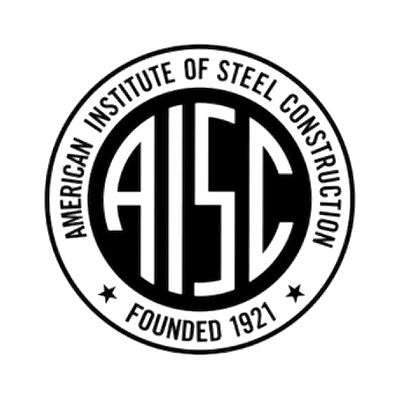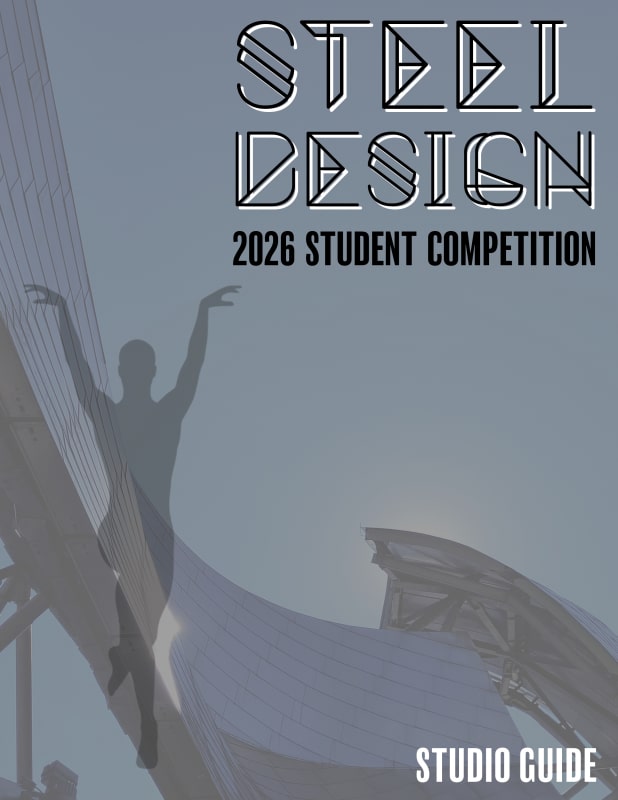Registration Deadline: April 8, 2026
2026 Steel Competition
Community Dance Center & Open
Program
Community Dance Center & Open
Category I: Community Dance Center
A Community Dance Center is a place where creativity and culture take center stage. Reflecting the aspirations and spirit of its dancers, these buildings foster a richly diverse environment – both artistically and socially – using performance, education, and imagination to serve their communities through a uniquely expressive artform. As these cultural centers continue to evolve, the performers and audiences alike are encouraged to explore new ideas, new forms of expression, and to celebrate the human spirit.
Design responses to this prompt should imagine a building that not only houses performance, practice, and education, but also serves as an engaging public space – one that integrates seamlessly into the fabric of the community, invites public interaction, and becomes a dynamic cultural catalyst through creative exchange.
Site
The site for the competition is the choice of the student and/or faculty sponsor. However, the site should be accessible by multiple modes of transportation such as public transportation, biking, or walking. Submissions will be required to explain the site selection, strategy, and access graphically or otherwise.
PROGRAM
The total area of the program may range depending on the community’s needs. The Community Dance Center program area total should be a minimum of 30,000 square feet and should be compatible size with the needs of the population served. Your building square feet can grow in size, without limitation, to appropriately meet the needs of chosen community and site.
As ballet and dance studios throughout the country continue to adapt to better serve their communities and expand their reach, the center may include both “typical” dance programs as well as public gathering and community spaces – the extent to which is to be determined by your analysis of the civic needs, site, etc. You are encouraged to consider creative ways that the center may make their performances more accessible to the public, specifically to members of the community who may not otherwise be exposed to dance as an outlet for creative expression or personal growth.
The performance and rehearsal studios should be designed to accommodate multiple forms of dance and different types of performances. These spaces will support both practice and performance, and should be one of the distinctive features of the center. The following spaces are general guides; students and faculty can adjust and expand on the program spaces to fit the center and community needs.
Outdoor Public Space
Flexible & Multi-Functional Outdoor Space |
Entry & Reception Area
Welcome Desk/Ticketing Counter | 500 sq. ft. |
Costume Display | 500 sq. ft. |
Lobby Seating Area | 1,000 sq. ft. |
Cafe | 1,000 sq. ft. |
Public Restrooms | 600 sq. ft. |
Entry & Reception Area Subtotal | 3,600 sq. ft. |
Performance & Rehearsal Studios
Large Studio | 4,000 sq. ft. |
Two (2) Medium Studios | 2,500 sq. ft. each |
Performance & Rehearsal Studio Subtotal | 9,000 sq. ft. |
Dancer’s Lounge Area
Two (2) Dressing Room/Locker Rooms | 600 sq. ft. each |
Two (2) Restrooms | 300 sq. ft. each |
Dancer’s Lounge Area Subtotal | 1,800 sq. ft. |
Classrooms
Two (2) Flexible, Multi-Purpose Classrooms | 1,000 sq. ft. each |
Classroom Subtotal | 2,000 sq. ft. |
Administration Suite
Six (6) Staff Offices | 100 sq. ft. each |
Creative Director’s Office | 200 sq. ft. |
Private Conference Room | 400 sq. ft. |
Break Room/Kitchenette | 400 sq. ft. |
Admin Restrooms | 300 sq. ft. |
Administration Suite Subtotal | 1,900 sq. ft. |
Operations Facilities
Production Office | 150 sq. ft. |
Film/Tech Room | 150 sq. ft. |
Stage Set Fabrication Shop | 2,000 sq. ft. |
Costume Shop | 800 sq. ft. |
Operational Facilities Subtotal | 3,100 sq. ft. |
Building Support
Public/Staff Parking | |
Loading Dock | 1,000 sq. ft. |
Storage | 1,000 sq. ft. |
Security Office | 100 sq. ft. |
Support Staff Restrooms | 500 sq. ft. |
Building Support Subtotal | 2,600 sq. ft. |
Building Totals
PROGRAMMATIC SPACE SUBTOTAL | 24,000 sq. ft. |
Services at 25% (corridors, mechanical, elevators, and other service) | 6,000 sq. ft. |
TOTAL BUILDING | 30,000 sq. ft. |
Construction Type
The project must be conceived in structural steel construction and must contain at least one space/element that requires long-span steel structure, with special emphasis placed on innovation in steel design. The most compelling proposals will inevitably integrate the use of steel into the design of the project at multiple levels, from primary structure to building envelope and tectonic details.
Performance Evaluation (For Category I only. Not required for Category II.)
Each student will answer a few multiple-choice questions upon submission about a performance analysis topic determined by the faculty or student(s). If possible, please show your performance evaluations on your submission boards and images. For the list of questions and an expanded explanation of this, please refer to the Supplemental Studio Guide and these questions:
- What category of performance did you measure or assess in your design?
- What standard or benchmark did you measure against?
- How did your final design performance compare with your standard or benchmark?
- If you measured and your design performance was below the standard or benchmark, did you redesign and measure or assess again?
Category II: Open
The ACSA/AISC 2026 Steel Design Student Competition also offers architecture students the opportunity to participate in an open competition with limited restrictions. With the approval of a sponsoring faculty member, students may select a site and building program.
- The Category II program should be of equal complexity as the Category I program.
- Students entering Category II must submit a written building program, including a brief description of the building type, gross square footage, and project location, as part of the online submission in the Program Edits (copy/paste text box).
Restrictions
To enter the open competition students may select any building occupancy other than a dance center.
Students may not enter both categories of the competition.
Construction Type
The design project must be conceived in structural steel construction and must contain at least one space/element that requires long-span steel structure, with special emphasis placed on innovation in steel design. The most compelling proposals will inevitably integrate the use of steel into the design of the project at multiple levels, from primary structure to building envelope and tectonic details.
Competition Organizers & Sponsors
Questions
Edwin Hernández-Ventura
Programs Coordinator
ehernandez@acsa-arch.org
202.785.2324
Eric W. Ellis
Senior Director of Operations and Programs
eellis@acsa-arch.org
202-785-2324

 Study Architecture
Study Architecture  ProPEL
ProPEL 



